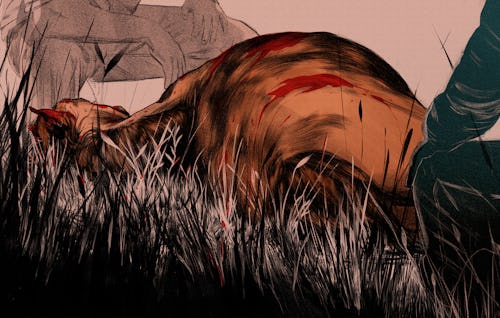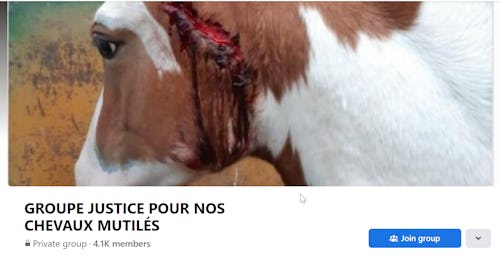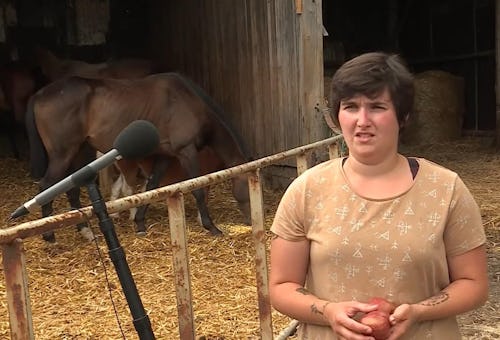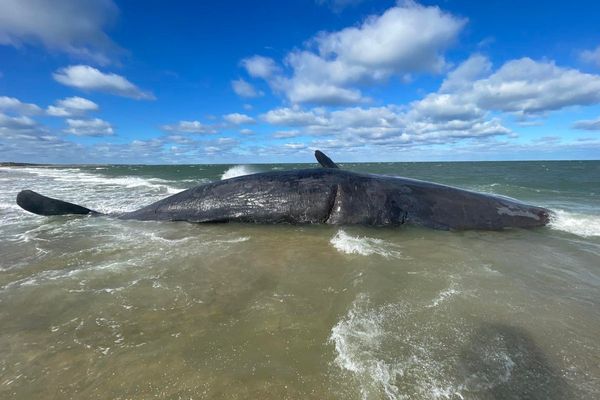
Early one morning last September, Melanie Cerdan-Rabaud was working on the western France stud farm she has owned for a decade when one of her neighbors called to say he had found a horse corpse in a nearby field.
Luxury, a foal, lay dead among the first autumn leaves, his blood still fresh on the grass. It looked to Cerdan-Rabaud as if the body had been dragged. When she peered closer, her heart sank. In that instant, she knew: The horse-killer gang had struck again.
“They always leave the same signature: They cut off the right eye and the right ear, a perfectly clean cut,” Cerdan-Rabaud tells me a few weeks later. “As soon as I saw that, I called the police.”

The gendarmerie arrived quickly. They knew the drill. Throughout France, the authorities had seen hundreds of similar cases. The attackers always struck at night. The next day, horses would appear dead, or horribly injured with deep cuts along their flanks or around their genitals.
The wounds looked “surgical,” many horse owners said, suggesting a professional, or several, were at work. An eye was taken, usually the right one; one ear was removed. There were no witnesses. Nor was there a discernible motive.
As the police examined the scene this time, they asked Cerdan-Rabaud to keep quiet for now. There was no need to create more panic. But she didn’t listen. She knew she needed to let her friends and colleagues know. Cerdan-Rabaud went to Facebook to describe the “cowardly torture” and “savage killing.” It was happening, again. And they needed to take precautions lest their horses be next.
It didn’t take long for the message to spread to a Facebook group called Justice for Our Horses. “Soon I had a huge number of shares, then I was contacted by a local journalist, and in no time we were on the front page of the newspaper,” she says. “All of a sudden, we were starting to make a lot of noise.”
The scare
The first dead horse stories started cropping up in the French news in spring 2020, but cases were few and far between and easily dismissed as isolated incidents. But by early summer things started to change.
In June 2020, Pauline Sarrazin, a horse enthusiast in her mid-twenties living in Normandy, found her horse, Lady, dying in a field. The animal’s ear was missing and the skin was peeled off its face, leading Sarrazin to suggest the animal might have been attacked with acid.
In interviews with the press, Sarrazin recalled several further troubling details from the days before the death — a drone flying over her property in the middle of the night, a suspicious individual trespassing on her property, and someone she believed was impersonating a vet calling for information about the horse — which evoked the specter of an an organized group behind the killings.

Sarrazin, who is ruddy-cheeked with cropped black hair, thought that authorities were missing the bigger picture. She created Justice for Our Horses to bring together anyone whose animal had been killed. “I just want to find the assholes who did this,” she told the TV news.
Soon, thousands of people had joined up, mostly horse owners and animal lovers, but also amateur sleuths. After reviewing old news reports with other members of the group, Sarrazin claimed to have found some 60 previous cases of attacks on horses going back as far as 2014.
According to Sarrazin, many of the cases had been overlooked. “The problem is that it’s never the same type of horse that is targeted or the same method of killing,” she told the French newspaper 20 Minutes. “The only link is that the ear is taken.”
As news of the mutilations grew, horse owners in France started reexamining the seemingly natural deaths of animals from months or years past, asking themselves if their animals hadn’t in fact been killed. Others were increasingly fearful that their animals might be next.
At its height, Justice for Our Horses counted some 20,000 members. The community shared tips and advice to ward off the attacks, from the best way to set up security cameras to how to detect signs attackers were surveilling a property.
They also posted their theories, some of them increasingly outlandish. One user warned that the perpetrators were drugging guard dogs during attacks. Others shared what they believed were signs left by the perpetrators; the smallest discoveries, from manure on a doorstep to carved marks on a fence post, were dissected at length by the community.
The attacks became a national concern. With no suspects and limited evidence, all theories were on the table. “Is it some kind of internet challenge? Or the work of one individual? Every explanation is being considered at this point,” said a police commander in central France in late June. Soon police were calling for vigilance and encouraging animal owners to report any suspicious deaths or possible suspects.
“[The attacks] raise questions about those responsible and their motives. Be they superstition, fetishism, satanic ritual, related to a cult or otherwise.”
Multiple attacks were reported hundreds of miles apart in the span of a few hours, confirming for many a suspicion that an organized gang was at work. France’s domestic intelligence service soon lent its weight to the idea, identifying “a clear, indiscriminate effort to attack horses and keep the ear as a trophy” in a report dated June 30, 2020. “[The attacks] raise questions about those responsible and their motives,” the report continued. “Be they superstition, fetishism, satanic ritual, related to a cult or otherwise.”
Sylvie Michel, a pensioner living in Normandy, followed the news and Facebook posts with alarm. She lives alone on an old farm a few miles from town with two horses. Fearing police wouldn’t arrive in time if someone attacked her property, she enlisted her two sons and neighbors to organize patrols of the local area.
For months, she would slip out of the house several times each night to patrol the field behind her. She left her flashlight behind, tracing the familiar steps she walked every day. “Each time I went out on rounds I took a pitchfork, pepper spray, and a rifle,” she tells me. “If they attacked me, I had to defend myself.”
One thing bothered her, though: “We put up cameras — some people even caught images of people — so why did they never catch anyone?” And then, one evening on the other side of the country, someone almost did.
The suspect
On a warm night in late August 2020, a little after 10 p.m., Nicolas Demajean, 48, made his final round of the day at his animal shelter in central France. He had been extra-vigilant when patrolling in recent weeks. After confirming everything was in order, he went to bed at his home on the property. He was sleeping soundly when, around midnight, he woke to the sound of pigs squealing nearby.
Demajean, who is disabled, made his way downstairs slowly, using a cane. When he reached the patio, he came face to face with two men. “They didn’t run away when they saw me,” he tells me. “They just came at me.” In the ensuing struggle, one attacker slashed Demajean across his left arm with a knife.
Demajean struck back with his cane, hitting the assailant across the face. Demajean’s dog pursued the other man before both men were able to escape in a 4x4 truck. Afterward, Demajean saw the men had attacked two horses and two ponies, leaving deep slashes across their bodies.
It was the first time anyone had spotted a suspect in any of the dozens of reported cases of horse mutilations across the country. In the wake of the sighting, Demajean gave police a detailed description of one of the attackers, a stocky white man between 40 and 50 years old, with short brown hair, brown eyes, and stubble.
Police distributed a digital sketch of the suspect, which was soon shared half a million times on Facebook. In the wake of the attack, an Associated Press dispatch picked up by the Washington Post, the Chicago Tribune, and Fox News, among others, puzzled over the “ritual-like mutilations.”
Police across the country dedicated extensive resources to the case. On Sept. 7, 2020, a 50-year-old unemployed man with prior drug convictions was arrested after a witness recognized him from the police sketch, only to be released soon after without charges.
Around this time, a hundred people every day were calling a government-run hotline for concerned animal owners. “They were really on edge and there was a pattern of people wanting to take action into their own hands,” says Mathilde Dhollande, a spokeswoman for the French Institute of Horses and Horse Riding, which is part of the Agricultural Ministry. “Mostly what we did is call for calm.” On the Justice for Our Horses group, frustration grew.
Politicians descended on the countryside to meet victims. Far-right leader Marine Le Pen met Demajean in front of cameras to pledge support for all those affected. “Harming animals with such cruelty is a sign of savagery,” she posted on Facebook.
Authorities sought not only to prevent attacks but to calm tensions among increasingly panicked rural communities. In Brittany — where only one alleged horse maiming had been reported but police were overwhelmed with calls of suspicious activity — officers in camouflage surveilled properties with night-vision in an operation dubbed War Horse.
With pandemic restrictions on movement only recently lifted, city dwellers and foreign tourists flooded to the French countryside right when locals were increasingly wary of outsiders. Sightings of suspicious vehicles were shared widely on Facebook. The head of a local equestrian center posted a series of photos of a white Suzuki Jimny 4x4 with foreign plates, which he said had stopped for extended periods in rest stops near fields where horses graze.
Local news reported that story, and posts appeared on Facebook using the same photo, sometimes in combination with the police sketch made of Demajean’s attacker. One all-caps post screamed, “JUST SPOTTED A FEW HOURS AGO IN ALSACE! THEY WERE DERANGED!” Police followed up, but the lead was a dead end. It turned out the vehicle belonged to a Dutch woman and her mother, two geocaching enthusiasts on holiday.
“It is a cult, that much is clear. Why else would they take an ear, or organs or testicles?”
In the midst of the panic, altogether fake stories also spread quickly. One tale posted on Facebook, later debunked by fact checkers, identified as suspects “two young assholes with knives” in southern France.
The scope of the alleged crimes and the lack of any arrests created a febrile atmosphere in which amateur sleuths parsed press reports and online rumors for clues to the identity of those behind the killings. One popular theory claimed that the horses were killed for their blood, perhaps for use in the production of vaccines against COVID-19. Far-right commentators on YouTube suggested the attacks might be part of a broader campaign of “low-level terrorism” waged by jihadists, possibly linked to the (accidental) 2019 fire at the Notre Dame cathedral.
But the most popular explanation was satanists or some kind of alternative religious group. “It is a cult, that much is clear. Why else would they take an ear, or organs or testicles?” asks Demajean, the man confronted by two attackers in August 2020. He says he has received several anonymous letters containing threats since the attack. “It has to be professionals because not anyone could do this,” he speculates. “I think it could be former vets or butchers.”
The hysteria
In September 2020, French police launched a huge investigation into more than 500 reports of horse killings or maimings. Police veterinarians and forensic experts reviewed each case before making a shocking announcement in December 2020: Only 16 percent of the cases reported could be formally linked to human action. More than 400 cases were classified as natural deaths.
Police confirmed several individuals were arrested in relation to isolated crimes, including one for bestiality. But no individual or group was brought to justice for committing attacks across the country. And there was no pattern of an attacker systematically taking horses’ ears or other body parts.
If there were no killers, how did almost everyone, from government ministers to farmers to police to the media coalesce around the idea that an individual or group was responsible for the deaths of so many horses? Across the border in Switzerland, Olivier Ribaux, a former police investigator and expert in forensics, had an idea.

Ribaux, now 58, was watching TV news when he first learned of the horse mutilations in France. He listened carefully, noting the startling similarities with a case he knew intimately from 15 years earlier. “As soon as I saw that, I said: ‘It’s starting again,’” he tells me.
In 2005, Ribaux was working as an analyst with the Swiss police when the force was hunting a mysterious killer — dubbed the Sadist by press — whom they believed was attacking animals and taking ears and genitals from their corpses as trophies. Amid a media frenzy, police began 24-hour surveillance of fields, while suspicious animal owners harassed tourists lingering near fields. No arrests were made.
The head of the judicial police in one canton, Olivier Guéniat, reviewed the evidence, testing all theories. One day, Guéniat, who died in 2017, told Ribaux he had cracked the case of the Sadist. “‘I know who it is,’ he told me,” Ribaux recalls. A note of mischief creeped into Guéniat’s voice: “It was a fox.”
Soon after, Swiss police announced their findings publicly: In most of the cases there was no evidence of human intervention. The Sadist never existed. Forensic experiments had shown what initial observations failed to realize: Most of the incisions, which were described as “surgical” and attributed to knives, were in fact the mark of the sharp teeth of a fox or similar scavengers, a theory confirmed by DNA samples.
Similar waves of animal attacks have been reported in other countries with no serial animal attacker ever convicted. A wave of reported cattle mutilations in New Mexico in the 1970s was eventually debunked by a former FBI investigator who blamed the injuries on scavengers. His final report included recommendations for police officers confronted with cases of purportedly mutilated animals: “Don’t use terms such as ‘surgical precision,’ which are conclusions. Stay with the facts, let the laboratory experts make conclusions. Also, don't be misled by statements made by non-authoritative sources.”
Later, British police investigated a “horse ripper” suspected of killing some 160 animals between 1983 and 1993. Widely reported theories suggested satanists or even pedophiles were behind the deaths, but no convictions were ever made. In 2001, after two decades of investigation, a former police officer declared that most of the injuries were caused by accidents or other animals. (A horse scratching itself on a bush can incur cuts that can be mistaken for knife wounds, says Dhollande.)
“Once the theory has been laid out and politicians, police, and the media converge around that, it makes it really difficult to offer any alternative.”
“Historically, events follow a similar pattern: rising numbers of attacks, no arrests, and the finger is pointed. What has changed over time is to whom the finger is pointed,” says Alan Jones, a British historian who has studied animal attacks in the U.K. “In earlier times, they would include the vagrants, the unemployed, or outcasts, whereas now we have pagans, witches, satanists, or spacemen.”
If, faced with our uncertainty, we often reach for scapegoats, previous cases of mass panics also point to our capacity to find evidence of a sinister plot in innocuous events. “When people are frightened or anxious they often reinterpret cues in their environment,” says Gary Small, an expert in mass hysteria and chair of psychiatry at Hackensack University Medical Center in New Jersey.
In these difficult situations, we look to others for explanations for what is happening, says Agneta Fischer, a professor in emotion and affective processes at the University of Amsterdam. “The more intense an emotional event, the more it will spread,” she says. “And by sharing stories and our emotions about them we can also share the same interpretations of that event.”
Each voice — the media, the police, the public — reinforced the theory of a serial attacker until it became the only theory, says Ribaux, the Swiss investigator. “In France we saw the same pattern: The case started, it was reported by TV, and people began organizing themselves, which was further amplified by social media,” he says.
The result was a textbook case of confirmation bias. “Once the theory has been laid out and politicians, police, and the media converge around that, it makes it really difficult to offer any alternative,” Ribaux says. “Even asking seems stupid at a certain point. It’s established: There is a serial killer, and that is something that we cannot contest.“
The end?
The panic over horse mutilations spread above all in the press and online. But some of these reports were later revealed to be false or entirely fabricated. Following a bad breakup, a man in eastern France claimed he and his horse were attacked, before later retracting and admitting that he had fabricated the story to win sympathy from his ex.
Then, this past June, Sarrazin, the creator of the Facebook group Justice for Our Horses was convicted of false testimony and mistreatment of animals. She had fabricated the story to protect her dog after it attacked and killed her horse, Lady. She was given a suspended four-month sentence and a ban from keeping animals for three years.
On the Facebook group she created, the public reaction was scathing. Some called for her to be locked up, while others encouraged people to contact her directly. “With scumbags like this we will lose all credibility,” complained one member.
“I told the police I’m going to keep looking into this, and we are organizing to make noise about this across France.”
The Facebook group, though diminished, remains active, and many users continue to believe one or several organized groups is killing horses. Demajean, whose attackers remain at large, doesn’t believe natural causes can explain the reported horse deaths and injuries, and has since installed cameras across his property.
“I’m 100 percent convinced that people did this,” he says. “They need to stop saying it was animals because animals don’t remove organs, and animals can’t open the thorax of a horse.”
Back in western France, Melanie Cerdan-Rabaud is still looking for the person she believes killed her foal. An autopsy concluded that Luxury died of natural causes, the wounds on his body inflicted post-mortem by animal scavengers. But Cerdan-Rabaud is unconvinced.
“The police asked me not to tell anyone about the case, but I didn’t listen,” she tells me. She is convinced that clues were lost due to flaws in the investigation. “I told them I’m going to keep looking into this, and we are organizing to make noise about this across France,” she says.
“It’s not over,” Cerdan-Rabaud continues. “These people are still out there. And they are still mutilating horses.”







